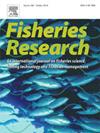Spatiotemporal variation in the reproductive dynamics of female American lobsters, Homarus americanus, on the northeastern continental shelf of the United States
IF 2.3
2区 农林科学
Q2 FISHERIES
引用次数: 0
Abstract
The American lobster, Homarus americanus, fishery in the United States occurs along the northeastern continental shelf. It is managed as two biological stock units – the Southern New England stock and the Gulf of Maine / Georges Bank stock. Recruitment has declined over the last decade, but there is a lack of broad-scale and high-resolution information on spatiotemporal variation in female reproductive traits, especially in offshore waters. This study addressed this issue using geolocated biological data sampled over an eleven-year period by the Commercial Fisheries Research Foundation’s Lobster and Jonah Crab Research Fleet. We detected significant heterogeneity in the spatial distribution of female lobsters, and in the spatial distribution and phenological variations in ovigerous lobsters. The prevalence of ovigerous female lobsters decreased in spring and increased in fall. However, the timing of the spring and fall events, and the magnitude of the summer decrease, differed between stocks and between areas within each stock. In general, warmer areas were associated with an earlier spring decrease, a later fall increase, and a greater depletion of ovigerous females during summer. Regional differences were associated with phenological variation in egg development. Our results provide the first shelf-wide, high-resolution overview of female lobster reproductive phenology on the U.S. continental shelf and offer a foundation for future research into links between lobster reproduction and long-term shifts in harvesting, environmental conditions, and conservation policies.
美国东北大陆架雌性美洲大螯虾繁殖动态的时空变化
美国龙虾(Homarus americanus)是美国东北大陆架一带的渔业。它被管理为两个生物库存单位-新英格兰南部库存和缅因湾/乔治银行库存。在过去的十年中,招募人数有所下降,但缺乏关于雌性生殖特征时空变化的大尺度和高分辨率信息,特别是在近海水域。这项研究利用商业渔业研究基金会的龙虾和约拿蟹研究舰队在11年的时间里取样的地理生物数据来解决这个问题。雌螯虾的空间分布具有显著的异质性,雌螯虾的空间分布和物候变化也具有显著的异质性。雌龙虾产卵率春季下降,秋季上升。然而,春季和秋季事件的时间以及夏季减少的幅度在不同的种群之间和每个种群内部的不同区域之间存在差异。总的来说,温暖的地区与早春减少,晚秋增加和夏季产卵雌性的更多消耗有关。区域差异与卵发育的物候差异有关。我们的研究结果首次提供了美国大陆架雌龙虾繁殖物候的全大陆架高分辨率概述,并为未来研究龙虾繁殖与捕捞、环境条件和保护政策的长期变化之间的联系奠定了基础。
本文章由计算机程序翻译,如有差异,请以英文原文为准。
求助全文
约1分钟内获得全文
求助全文
来源期刊

Fisheries Research
农林科学-渔业
CiteScore
4.50
自引率
16.70%
发文量
294
审稿时长
15 weeks
期刊介绍:
This journal provides an international forum for the publication of papers in the areas of fisheries science, fishing technology, fisheries management and relevant socio-economics. The scope covers fisheries in salt, brackish and freshwater systems, and all aspects of associated ecology, environmental aspects of fisheries, and economics. Both theoretical and practical papers are acceptable, including laboratory and field experimental studies relevant to fisheries. Papers on the conservation of exploitable living resources are welcome. Review and Viewpoint articles are also published. As the specified areas inevitably impinge on and interrelate with each other, the approach of the journal is multidisciplinary, and authors are encouraged to emphasise the relevance of their own work to that of other disciplines. The journal is intended for fisheries scientists, biological oceanographers, gear technologists, economists, managers, administrators, policy makers and legislators.
 求助内容:
求助内容: 应助结果提醒方式:
应助结果提醒方式:


